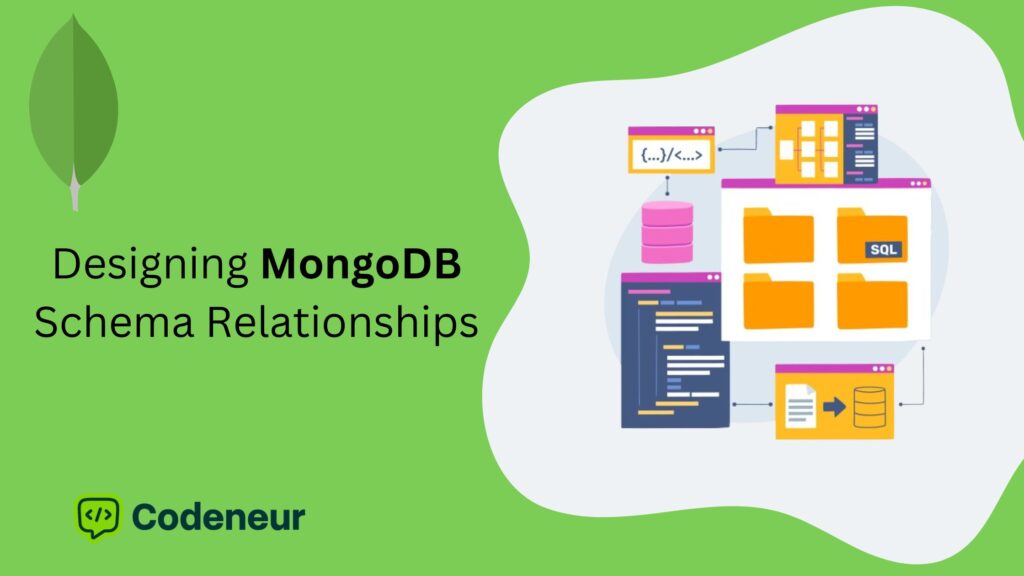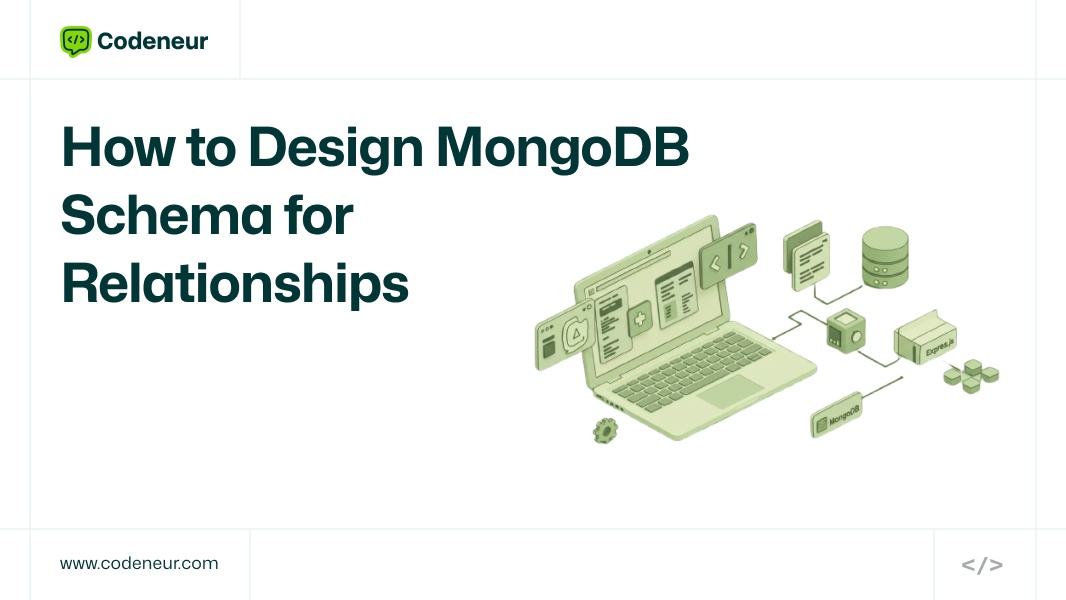MongoDB is a popular NoSQL database that is very flexible and scalable when it comes to storing large datasets. While MongoDB schema refers to the structure and organization of data stored in a MongoDB collection. Lets learn how to Design MongoDB Schema for Relationships.
When working on MongoDB, most challenges developers need to overcome center on designing schema for handling good relations between your data.
There’s a tendency of relational data stores that really make use of tables and relationships, while using foreign keys on how they implement such relations while MongoDB is truly NoSQL- Using collections to manage documents.
The way you design relationships in your MongoDB schema will significantly impact performance, scalability, and data integrity.

In this blog post, we’ll explore various methods for establishing relationships in MongoDB, including embedding and referencing, and discuss how each approach can be leveraged depending on your project’s requirements
Understanding Relationships in MongoDB
What are Relationships in MongoDB?
In the context of databases, relationships define how different data entities are connected to each other. In MongoDB relationships can exist in three primary forms:
- One-to-One: One document in a collection relates to exactly one document in another collection (e.g., a user and their profile).
- One-to-Many: One document in a collection relates to multiple documents in another collection (e.g., a blog post and its comments).
- Many-to-Many: A number of documents in one collection are related to a number of documents in another collection (students and courses, for example).
Why Do We Need Relationships in MongoDB?
MongoDB lets you structure your data using flexible, scalable designs, but as applications scale, relationships between entities (for example, users and their orders, or products and categories) become necessary for representing real-world complexities.
The right schema design helps maintain the integrity of connected data.
Design MongoDB Schema Relantionships
Lets explore various methods for establishing relationships in MongoDB, including embedding and referencing, and how they impact on performance, scalability, and data integrity.
Embedded Relationships in MongoDB
Embedded Documents (Denormalization)
The process of placing one document within another is embedding. Since MongoDB has denormalization, the embed can be ideal for the required cases.
This is perfect for scenarios in which the information to be inserted should have a lot of integrity, and read mostly as one piece of information.
For example, in a One-to-Many relationship, you could embed a list of comments inside a blog post document.
Then you could easily get both the post and all its comments in one database operation.
const blogPostSchema = new mongoose.Schema({
title: String,
content: String,
comments: [
{
user: String,
message: String,"}
date: Date
})
];
};References (Normalization)
References means storing the data in different collections and linking them together using unique identifiers, such as MongoDB ObjectIds.
This helps when data is huge or belongs to many different entities, so it reduces duplication of data.
For instance, in a One-to-Many relationship, you can store comments in a separate collection and then reference the blog post’s ID.
Example
const commentSchema = new mongoose.Schema({
user: String,
message: String,
date: Date,
postId: { type: mongoose.Schema.Types.ObjectId, ref: 'BlogPost' }
});One-to-One Relations in MongoDB
Embedding for One-to-One Relations
In case of strongly coupled relation like user and its profile, document embedding into one another is also a viable solution.
It leads to better fetching of data and reduces the time complexity to only one query rather than two or more.
const commentSchema = new mongoose.Schema({
user: String,
message: String,
date: Date,
postId: { type: mongoose.Schema.Types.ObjectId, ref: 'BlogPost' }
});Use References for One-to-One Relations
Sometimes, it may be quite reasonable to keep them in different collections, especially if the profile is large or needs to be accessed separately.
Example
const userSchema = new mongoose.Schema({
username: String,
profileId: { type: mongoose.Schema.Types.ObjectId, ref: 'Profile' }
});One-to-Many Relations in MongoDB
Embedding for One-to-Many Relations
Embedding is often preferred when the “many” items, such as comments, are unlikely to be accessed independently of the main document, in this case, the blog post. This ensures that all the related data is fetched in a single query.
Example: Embedding comments in a blog post schema.
const blogPostSchema = new mongoose.Schema({ title: String, content: String, comments: [ { user: String,
message: String,
date: Date
}
]
});Referencing for One-to-Many Relationships
When the related data is used in a different context or becomes large, referencing may be a better option.
Example: Storing products in an order.
const orderSchema = new mongoose.Schema({
customerId: { type: mongoose.Schema.Types.ObjectId, ref: 'Customer' },
products: [{ type: mongoose.Schema.Types.ObjectId, ref: 'Product' }],
totalAmount: Number
});Many-to-Many Relationships in MongoDB
Modeling Many-to-Many Relationships
In a many-to-many relationship, data from two collections are associated with multiple documents in each collection. MongoDB can handle this by creating an intermediary collection that stores the relationships.
Example: A student can enroll in many courses, and a course can have many students. Here’s how you might set up an enrollment collection to manage this many-to-many relationship.
const enrollmentSchema = new mongoose.Schema({
studentId: { type: mongoose.Schema.Types.ObjectId, ref: 'Student' },
courseId: { type: mongoose.Schema.Types.ObjectId, ref: 'Course' },
enrollmentDate: Date
});Data Integrity in MongoDB
MongoDB doesn’t enforce strong data integrity as relational databases but developers can be implementing ways of ensuring data integrity
- Transactions: MongoDB 4.0 and above supports multi-document transactions which help in achieving consistency across a set of operations.
- Application-level Integrity: You can put validation checks right into your application code to check that data comes in according to your desired constraints.
MongoDB Schema Design Best Practices
Schema Design for Efficient Querying
Always design keeping your query patterns in mind. MongoDB is a read-heavy platform, so schematically designing to support these workloads will highly optimize performance.
- Avoid Over normalizing: Fearless Denormalize Wherever is Required and not against norms at all performance conditions. This balancing between both aspects should be tried.
- Index: Index helps much in speeding-up a query process particularly for some of large data.
Conclusion
Choosing the right MongoDB schema for relationships will dramatically affect your database’s efficiency and performance.
You can achieve optimized data retrieval, minimize redundant data, and ensure scalability with the choice of either embedding documents or referencing collections.
The complexity of relationships and the needs of your application along with your data access patterns dictate the right choice.
If you’re looking to master MongoDB and NoSQL databases, consider joining the Codeneur’s ultimate Full Stack Developer Bootcamp. Our comprehensive course provides hands-on training in MongoDB, database design, and much more.
By enrolling, you’ll gain the practical skills needed to design efficient schemas, solve complex data problems, and boost your career as a proficient full-stack developer.
Don’t just learn theory—instead get hands on practical skills that employers are looking for!
Key Takeaways
One-to-one, one-to-many, and many-to-many relationship types are available in MongoDB. However, this article mainly talks about how the relation allows you to connect data present in two separate collections
Embedding vs. Referencing
Embedded Documents (Denormalization): The embedding of data within other documents is useful in cases where the related data are often accessed together
References (Normalization): Storing the related data within separate collections but linking them via ObjectIds would be ideal in cases of bigger, more complex data or the data is very frequently updated.
Selecting an appropriate approach
One-to-one Relationships: Using embedding with heavily coupled data for example the User and User-Profile where Referencing can be used, depending on data amount or where is fetched differently.
- One to many relationships, If related data can always be loaded together Embed but for a case of massive dependent data use the referencing one, and this occurs when a small amount of dependant data loads independently.
- Many-to-Many Relations: A junction collection (intermediary collection) can be used to store the relationships between two collections, like students and courses.
Data Integrity and Performance
MongoDB offers flexible schema design but doesn’t enforce strict data integrity. Developers need to use transactions (MongoDB 4.0+) and application-level validation to ensure data consistency.
Design the schema with consideration of query patterns so that it really performs well, especially for those read-heavy applications.
MongoDB Schema Design Best Practices
- Indexing: Ensure the indexing of your collections is proper to improve query performance.
- Avoid Over-Normalization: The art of denormalization and normalization should be balanced to ensure performance and scalability.
Course and Learning Opportunities
Codeneur’s Full Stack Developer Bootcamp also offers hands-on training in MongoDB schema design as well as full-stack development that will help master these skills.

